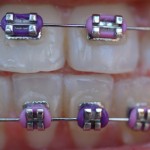
The aim of this review was to assess the effectiveness, efficiency, and potential side effects of the various archwires used during fixed appliance orthodontic treatment.
Searches were conducted in Medline, Cochrane Library, Biomed Central, BBO including LILACS, Ind Med, Sceilo, Clinical trials.gov, Conference paper Index, Digital Dissertations, German National Library of Medicine (ZB MED), Google Scholar, ISI Web of Knowledge, metaRegister of Controlled Trials, OpenSIGLE, Scirus. Randomized controlled trials (RCTs) and quasi-RCTs in patients having fixed-appliance orthodontic treatments were considered. Study selection, data extraction and risk of bias assessment with the Cochrane risk of bias tool were carried out independently by two reviewers.
- 16 RCTs involving 1108 patients were included.
- 13 trials (863 patients) considered initial archwires assessing cross-section of archwires , N+ implantation of archwires , and archwire materials.
- A meta-analysis of 2 trials found slightly greater irregularity correction with an austenitic-active nickel-titanium (NiTi) compared with an martensitic-stabilized NiTi archwire (corresponding to MD: 1.11 mm, 95% CI: -0.38 to 2.61).
- 4 trials (394 patients) considered archwire sequences
- A meta-analysis of two trials found it took patient treated with a sequence of martensitic-active copper-nickel-titanium (CuNiTi) slightly longer to reach the working archwire (MD: 0.54 months, 95% CI: -0.87 to 1.95) compared with a martensitic-stabilized NiTi sequence. However, patients treated with a sequence of martensitic-active CuNiTi archwires reported general greater pain intensity on the Likert scale 4 h and 1 day after placement of each archwire, compared with a martensitic-stabilized NiTi sequence
The authors concluded
There is insufficient data at present to make recommendations for the use of any available arch- wire type regarding effectiveness, efficacy, treatment outcome, or potential side effects. The meta-analyses conducted are limited by the small number of trials and methodological issues and must therefore be subsequently confirmed.
Comment
This review is one of a pair of review of orthodontic treatment conducted by the same group (Dental Elf 23rd May 2014). The Cochrane Oral Health Group has a review that has also assessed the effectiveness of initial archwires for orthodontic alignment (Jian et al 2013). The second update of that review was published last year. They only included 9 RCTs involving 571 patients and concluded
There is no reliable evidence from the trials included in this review that any specific initial arch wire material is better or worse than another with regard to speed of alignment or pain. There is no evidence at all about the effect of initial arch wire materials on the important adverse effect of root resorption.
Links
Papageorgiou SN, Konstantinidis I, Papadopoulou K, Jäger A, Bourauel C. A systematic review and meta-analysis of experimental clinical evidence on initial aligning archwires and archwire sequences. Orthod Craniofac Res. 2014 May 29. doi: 10.1111/ocr.12048. [Epub ahead of print] PubMed PMID: 24889143.
Jian F, Lai W, Furness S, McIntyre GT, Millett DT, Hickman J, Wang Y. Initial arch wires for tooth alignment during orthodontic treatment with fixed appliances. Cochrane Database Syst Rev. 2013 Apr 30;4:CD007859. doi: 10.1002/14651858.CD007859.pub3. Review. PubMed PMID: 23633347.
